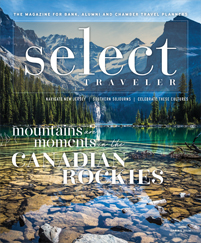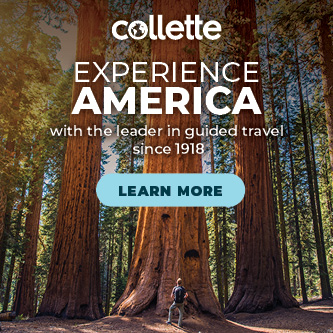What is it that makes train travel so special?
Is it the sound of a whistle in the distance, the chuffing of the engine as it spews puffy clouds of smoke or the clackety-clack of wheels moving in tandem as the train winds along the track?
Maybe it’s the romance of riding by rail, a moment when passengers can slow down and enjoy the view. Away from the stress of everyday life, travelers can read, write, rest, socialize and even enjoy a cocktail in the dining car. Hearkening back to a long-gone era, the nostalgia of riding trains is real.
These days, the journey itself is the destination, with train trips offering a view of landscapes not seen along the road more traveled. Railways are offering unique experiences, too, from live entertainment and wine tastings to holiday-themed rides and even murder-mystery experiences.
From coast to coast, America’s train travel is alive and well, presenting an unusual entertainment option and a way to experience a place.
Durango-Silverton Narrow Gauge Railway
Durango, Colorado
Durango, in southwestern Colorado, is near Mesa Verde National Park and the Four Corners. Founded in 1880 in the Animas River valley of the San Juan Mountain Range, the city was created by the Denver and Rio Grande Railroad to serve the area’s mining community. Two years later, rail tracks to Silverton were completed. The train was to transport ore, but even in those days, the railway was touted as a scenic travel route.
Over the next century, the train fell into disrepair until a large-scale restoration project revived the railway. In the 1980s, it built up its tourism and now provides year-round service, running a 100 percent coal-fired, steam-operated route with locomotives dating to the 1920s. Trips depart from Durango’s hub for five-hour jaunts through scenic Cascade Canyon, winding along the Animas River and arriving in Silverton, a former mining town that has maintained its historic charm. Its downtown district is lined with old-fashioned saloons and restaurants whose staffs don period dress.
The railroad offers several ride options. There are half-day trips for those who want to spend part of the day exploring Silverton, rides with wilderness stops for backpackers that let them get off to camp or hike, and wine- and beer-tasting trains with live entertainment or historic narration whose rides culminate with a picnic in the woods.
It’s worth the extra money to sit in the Nomad and Rio Grande cars, which send riders back to the golden era of rail travel. And upon arriving in Silverton, visitors won’t want to miss the Strater Hotel, a trip back to the Wild West, furnished with antiques and a Wild West saloon.
Grand Canyon Railroad
Williams, Arizona
There may be no more spectacular way to get to the majestic Grand Canyon than by train. Completed in 1901 by the Atchison, Topeka and Santa Fe Railroad, the Grand Canyon Railroad was built with the idea of transporting ore. That didn’t pan out, but the train became a popular tourist attraction as more people headed west to see the Grand Canyon. Among notable riders have been several presidents and Hollywood celebrities.
The role of the railroad in the development of the Canyon’s South Rim was significant. In 1904, the Atchison, Topeka and Santa Fe Railroad hired Fred Harvey, owner of a chain of railroad hotels across the country and creator of railroad dining service, and his architect, Mary Jane Colter, to design the Grand Canyon’s iconic hotels, among them Pueblo Indian-inspired El Tovar. The train cars include diesel locomotives, Pullman cars, vintage coaches, parlor and first-class cars, and observation dome cars.
Today, riders can choose between riding in historic Pullman cars or the Luxury Observation Dome. The train departs from Williams, Arizona, and makes a two-and-a-half-hour trip to the South Rim, where it allows for a few hours of exploration before its return. The ride includes entertainment: musicians playing the music of the Old West, historical anecdotes and Native American dancers. Overnight guests can choose one of the many hotel options to take in all the Grand Canyon has to offer.
Cass Scenic Railroad
Cass, West Virginia
The 11-mile-long Cass Scenic Railroad encompasses the former timber company town of Cass, West Virginia, and part of the summit of Bald Knob, Back Allegheny Mountain’s highest point. Founded in 1901 by the West Virginia Pulp and Paper Company, Cass served the local lumberjacks.
Visitors today ride on converted open-air log cars, climbing steep inclines pushed by a logging locomotive. The locomotives are maintained and restored by volunteers and include eight Shay locomotives, a Heisler locomotive and a Climax locomotive.
Trips include everything from two-hour to daylong excursions. The two-hour Whittaker trip goes four miles away to Whittaker Station, an authentic re-created logging camp, where riders can explore and play outdoor games. The Bald Knob trip takes four-and-a-half hours and includes the peak’s scenic overlook and an astronomy observatory, plus a stop at Whittaker Station for a “hobo lunch.” There are specialty train rides like the Polar Express and the Elf Limited, holiday trains that are great choices for families. And the Mountain Explorer Dinner Train is a four-hour excursion to the remote High Falls of Cheat and includes a four-course meal.
The railway offers unusual overnight options, too. The Wild Heart Connector Package goes to Old Spruce, with a transfer to the Cheat Mountain Salamander, and ends in Elkins, West Virginia, where guests enjoy a hotel stay, a dinner and a show. Twenty of the former company houses in Cass are also available for overnight rental. Popular in winter because of nearby Snowshoe Ski Resort, the houses are also available in spring and summer. The Castaway Caboose takes the Durbin Rocket to a remote riverside camp, where cabooses have been converted into fully modern accommodations.
Alaska Railroad
Alaska
The options for riding the Alaska Railroad are nearly as vast as the territory itself. Its main line runs 470 miles from Seward to Fairbanks, Alaska, and all points in between. The track was completed in 1923; President Harding personally drove in the Golden Spike to celebrate its completion. The railroad operates year-round with seasonal variations.
There are five main routes available: On the Coastal Classic, a day stop in Seward, offers options like a cruise through Resurrection Bay or Kenai Fjords National Park; a scenic ride to a remote island lunch; a trip to Exit Glacier and a dog sled ride at Seavey kennel; or a day in town exploring shops, restaurants and the sea life center.
On the Denali Star, the route runs from Fairbanks to Anchorage, Alaska, with a stop at Denali National Park for a day trip or a multiday excursion. Hurricane Turn heads into the Indian River Valley to remote cabins, hunting and fishing.
The Glacier Discovery route makes several stops. In Portage groups can visit the Alaska Wildlife Conservation Center, home to black and brown bears, moose, caribou, wood bison and other wildlife. In the port town of Whittier, Alaska, visitors can take a glacier and wildlife cruise in Prince William Sound before exploring the Spencer Glacier Whistle Stop, a gravel path leading to Spencer Lake and its glacier, where rafting, hiking and ice climbing are all available activities.
The Aurora Winter train travels the same route as the Denali Star, but in the winter months instead, offering travelers the opportunity to head into Alaska backcountry and ski the trails at Talkeetna, Alaska, or take a train-in/fly-out option, popular for guests who want to attend events like the March Fur Rendezvous or the Iditarod Sled Dog Race in Anchorage.
Mount Washington Cog Railway
Conway, New Hampshire
The world’s first cog railway runs up the Northeast’s highest peak, Mount Washington, which sits at 6,288 feet high. Fifteen years after summiting the mountain and nearly dying, meat-packing mogul Sylvester Marsh succeeded in launching his engineering feat when in 1869, “Old Peppersass” first climbed the mountain. The railway, a designated National Historic Engineering Landmark, celebrates its 150th anniversary in 2019, with a program of special events celebrating the occasion, including an employee reunion and ending in a public birthday bash.
The train operates with vintage steam engines, replica coaches and environmentally friendly biodiesel locomotives and is in the process of a multiyear upgrading project. Though the coaches are modern and state-of-the-art, they’re built and designed on-site at the railway’s base to replicate the experience travelers would have had in the early 1900s. In the late 1800s, visitors took stagecoaches to the Marshfield Base Station before traveling by rail to hotels at the top of the peak, a voyage that’s re-created daily today.
The three-hour round-trip is a narrated journey through history and a stunning natural landscape. The climb to the top ends with an hour of exploration at the visitor center and a 360-degree view of five states, Canada and the Atlantic Ocean. The rise in altitude creates a significant drop in temperature, something detailed in a visit to the weather observatory at the top.









